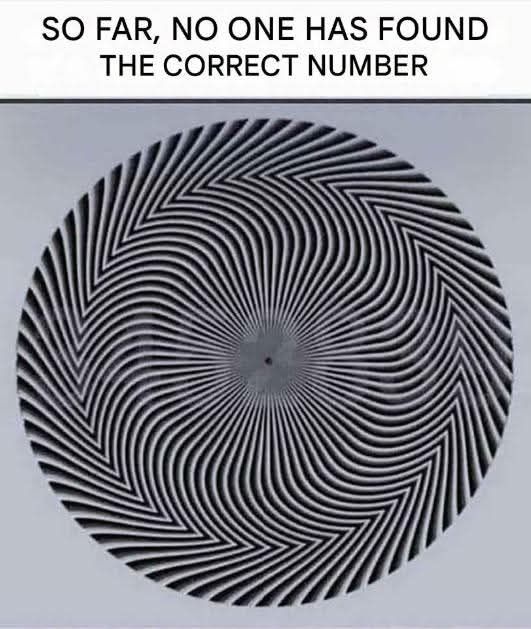April 2025 by admin
The internet has once again fallen under the spell of a visual illusion — one deceptively simple, yet maddeningly perplexing image that’s making people question their eyes and minds. The image, now viral on social media platforms, asks viewers to identify a number hidden within a grayscale gradient. The twist? Different people see completely different numbers.
While some confidently proclaim “528,” others argue they see “45283” or even longer sequences. The real kicker? The actual hidden number is 3,452,839 — a full seven-digit figure artfully camouflaged within varying shades of gray.
This is more than just an internet curiosity. It’s a fascinating look at how we perceive the world around us — and how easily our brains can be tricked.
Why Do People See Different Numbers?
This visual puzzle cleverly manipulates a specific aspect of our vision known as contrast sensitivity — the eye’s ability to distinguish objects from their background when the contrast between the two is low.
In the illusion, the center digits have a stronger contrast with the background and are generally more visible. As the digits fan outward, the contrast becomes more subtle and difficult to perceive. The further you move from the center, the harder the digits are to detect — unless your eyes are particularly good at noticing these slight shifts in tone.
This variance leads to dramatically different experiences. A person with sharper contrast sensitivity may see the entire number clearly, while someone else — even with perfect visual acuity — might only catch a portion.
Understanding Contrast Sensitivity
Most of us are familiar with visual acuity — how well you can see the details of objects, usually measured by how clearly you can read letters on an eye chart from a set distance. But contrast sensitivity is different. It measures how well you can distinguish an object that doesn’t stand out much from its background.
Everyday Examples of Contrast Sensitivity at Work:
- Driving in fog, when road signs are muted
- Reading faded print on a page
- Spotting a friend wearing gray on a cloudy day
- Navigating dim hallways at night
In each case, the objects are visible, but the difference between them and their surroundings is so subtle that your eyes have to work harder to identify them.
How the Illusion Works
The illusion behind the viral number image is built on gradual shading and edge blending. Here’s how it fools the brain:
- High Contrast in the Center: The middle digits, like the “2” and “8” in many perceptions, are darker against a lighter background. This makes them pop more clearly to most viewers.
- Fading Edges: Toward the ends of the number (like the “3” or “9”), the difference between the digit and the background becomes subtler. For some viewers, these digits may appear ghostlike — or not at all.
- Neural Interpretation: Your brain constantly tries to “fill in the blanks” based on what it expects to see. If it finds a number it recognizes — like 528 — it may stop processing further, even though other digits are present.
- Device and Display Factors: Brightness settings, screen resolution, ambient lighting, and even device type (phone vs. desktop) can influence what you perceive.
A Simple Test of Your Visual Acuity — Or Is It?
While this illusion may look like a fun puzzle at first, it doubles as an informal contrast sensitivity test. The ability to spot the full number — 3,452,839 — often indicates strong contrast sensitivity and visual processing.
That said, if you couldn’t see the whole number, there’s no reason for alarm. Everyone’s eyes interpret shading and brightness a little differently. This test isn’t a substitute for a professional eye exam — but it does offer a playful way to assess how your visual system handles subtle gradations.
Can You Improve Your Contrast Sensitivity?
Yes! While genetics and age play a role in your natural contrast sensitivity, there are several ways to sharpen your visual edge.
1. Eye-Friendly Nutrition
A diet rich in eye-healthy nutrients — especially lutein, zeaxanthin, and omega-3 fatty acids — supports the macula, the part of your eye responsible for detail and contrast. These nutrients are found in:
- Leafy greens like spinach and kale
- Eggs
- Fatty fish like salmon and tuna
- Carrots and sweet potatoes
2. Proper Lighting
Avoid eye strain by ensuring your environment has balanced, glare-free lighting. Try task lighting when reading or working, and avoid backlit screens in dark rooms.
3. Visual Exercises
Just like physical workouts strengthen muscles, your eyes can benefit from regular optical training. Puzzle books, contrast puzzles, and apps designed to enhance perception can subtly improve your eyes’ response to shading and motion.
4. Regular Eye Exams
An optometrist can detect early signs of diseases like glaucoma or macular degeneration — both of which impact contrast sensitivity. They can also fine-tune your corrective lenses to optimize visual performance.
Why Optical Illusions Matter
Beyond fun and games, illusions reveal how the brain and eyes interact to make sense of the world. We tend to assume that what we see is objective — but in reality, it’s often the brain’s best guess based on incomplete information.
This illusion in particular shows how easily our perception is influenced by subtle environmental factors — lighting, expectation, previous experiences — and highlights a powerful truth: Seeing is not always believing.
A Window Into Human Perception
There’s something inherently fascinating about visual puzzles that go viral. They unite us through shared confusion — and shared wonder. They challenge our assumptions and encourage us to look twice at the world around us.
This specific number illusion has joined the ranks of internet classics like:
- The Dress (blue/black or white/gold?)
- Spinning Dancer (clockwise or counterclockwise?)
- Checker Shadow Illusion (same shade or different?)
Each of these puzzles illustrates not only how flexible — but how subjective — our senses really are.
The Role of Expectations in Perception
Did you know your brain uses mental shortcuts when interpreting images? These are called perceptual heuristics — and they’re the reason illusions work.
When your brain sees part of a pattern (like 528), it often stops analyzing and fills in the rest based on expectation. That’s why many people don’t notice the rest of the digits at first glance.
This isn’t a flaw — it’s efficiency. But illusions like this expose those shortcuts and show just how tricky perception can be.
Tips for Spotting Hidden Images and Enhancing Perception
If you love puzzles like these and want to train your eyes to catch more details, try the following:
1. Change Viewing Angles
Look at the image from a different distance or tilt your head slightly. Sometimes the shift in light and perspective helps hidden elements pop.
2. Squint Your Eyes
This reduces peripheral noise and sharpens edges, making it easier to detect contrast.
3. Adjust Screen Settings
Try increasing your screen brightness or contrast, or switch between dark and light modes on your device.
4. Take Breaks
Give your eyes a rest! Fatigued eyes are less likely to detect subtle shifts in shading or detail.
Conclusion: More Than Just a Game
In the age of viral content, optical illusions offer a rare gift: a moment of curiosity, introspection, and communal wonder. Whether you spotted all seven digits or only a few, this visual puzzle is a reminder of the amazing complexity of human perception.
So the next time you find yourself squinting at an internet mystery, embrace the experience. It’s not just about getting the right answer — it’s about appreciating the incredible way your mind and eyes work together to interpret the world.
And who knows? The more you train your perception, the more hidden wonders you’ll begin to see — in illusions, in images, and in life.





